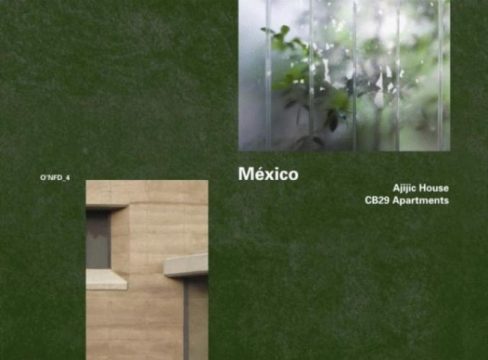With this fourth O’Neil Ford Duograph, The Center for American Architecture and Design together with the O’Neil Ford Chair in Architecture at The University of Texas at Austin are publishing another set of buildings by two architects from one country. Without doubt Tatiana Bilbao and Derek Dellekamp are two outstanding figures of contemporary Mexican architecture. Their body of work is not only extensive; it also shows a research approach that is quite unlike that of any other of their international colleagues. Included in this fourth volume are sketches, drawings and photographs as well as two analytical essays by Mexican critics and statements on the two buildings, all providing the discursive context as well as insights into the selected buildings‘ significance.
A single family house on a lake front in the Méxican state of Jalisco and a medium rise apartment building at the center of México City are representative of the common building types being constructed all over the Americas, including México. On their own, the two buildings presented in this Duograph each underscore their intellectual sources, be they in the world of art or in the realm of urban modes life. However, beneath these common traits are the building’s special identities as well as their conceptual and experimental affinity, two issues explored in detail by this book’s accompanying analytical essays.
House and apartment building are two genres in which architects across the world continue to show their skills to develop and innovate: whether in typological-spatial, or in constructional-detailing terms. The offices of Tatiana Bilbao and that of Derek Dellekamp, while both relatively young practitioners, have each already demonstrated their design abilities across a broad range of work. Most notably the large collaborative project of the Ruta Peregrino of 2008–2010, also in the state of Jalisco, which not only underlines Tatiana Bilbao and Derek Dellekamp’s openness towards collaborations with artists, but also exemplifies their inventive way of assembling program, site and personal architectural agendas.
México is a country, like many of its southern American counterparts, that enjoys a vibrant and open future. Notwithstanding widespread poverty, social inequalities, suburban sprawl, creaking infrastructure, the war on drug cartels, the country and its inhabitants exude a palpable optimism that has in the last years been able to relegate the enormous problems to another, albeit constantly present background. It has not hindered architects such as Tatiana Bilbao and Derek Dellekamp to conduct forms of research that are quite exceptional amongst the architectural profession worldwide in general and specifically to look into the nature of contemporary domesticity, be it suburban or urban in its context.
The Ajijic House begins with an exploration of dualities and transcends abstract orders to reach a self-reflective reality and a grafting with the site. The initial internal, geometric and ascribed logic of oppositions ¬– public versus private, common spaces versus bedrooms, view towards the lake versus view towards the land, etc. – is merged with the haptic phenomenon of the compacted earth walls and the wooden linings.
The CB29 Apartments are a high point in Dellekamp’s research into dense, inner city residential typologies. The subtle, small interlocking volumes between the horizontal layers create internal identities that are contextual despite the apartment building’s sober exterior. In this sense, the CB29 Apartments embrace both the sublime of the Miesian shoebox as well as the specificity of a tailor-made suit, a specificity that is applied to create distinct internal spaces.
- Veröffentlicht am Sonntag 25. März 2012 von Wasmuth, E
- ISBN: 9783803007414
- 144 Seiten
- Genre: Architektur, Kunst, Literatur, Sachbücher
